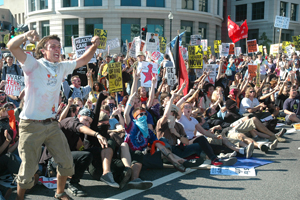Youth and students cut artery to Capitol
By
Peter Gilbert
Washington, D.C.
Published Oct 4, 2007 1:42 AM
For more than six hours following the Troops Out Now Coalition’s march on
Sept. 29 to cut off the funds for the Iraq and Afghanistan wars, more than 100
youth and students from across the country blockaded Constitution and
Pennsylvania avenues, the major roads leading to the Capitol building. They
demanded an end to war funding and vowed that if the people’s resources
continue to be used to wage imperialist war, the government will be prevented
from operating.
|
Protesters occupy the intersection on
Constitution and Pennsylvania Avenues.
WW photo: Liz Green
|
Youth from as far away as Oregon, Florida and Vermont, and representing
chapters of Students for a Democratic Society (SDS), Fight Imperialism, Stand
Together (FIST), Campus Anti-War Network (CAN), Iraq Veterans Against the War
(IVAW) and others, together with TONC leaders, united in the streets around a
common demand of “Troops Out Now!”
As the march approached its destination at the Capitol building, hundreds of
youth ran forward to block Constitution Avenue, and as the main body of the
march passed the action many more joined in. Despite the willingness of many of
the youth to risk arrest in order to close access to the Capitol, D.C. police
were apparently overwhelmed by the size and militancy of the action.
After holding Constitution for an hour, the youth moved one block to take over
the busier intersection where Constitution and Pennsylvania avenues meet. All
six lanes of Constitution were blockaded so successfully that youth felt free
to dance, string up banners and signs from the traffic lights, and even order
pizza.
After several hours it became clear that the police did not have the political
will to take back the streets, so youth erected tents and organized themselves
into security and logistical teams, preparing for a long stay. Around 10 p.m.,
after more than six hours, all the activists triumphantly marched back to the
Encampment, chanting “Whose streets? Our streets” with a whole new
meaning.
On Friday afternoon, in another display of student power, the same youth had
taken over the busy D.C. streets in an unpermitted march to unmask the
hypocrisy of the government and point out the effects the war has had even on
youth at home in the U.S.
Marching first on the Department of Education, they blocked the entrances which
ironically proclaim “No child left behind,” and demanded money for
adequate education and college loans, rather than the current policy of
increasing education costs to force youth into the military.
At the Department of Injustice, Tyneisha Bowens of Raleigh FIST proclaimed the
closing of the building, demanding “Free the Cuban Five! Free the Jena
Six! Free Mumia Abu-Jamal! Free all political prisoners! No longer will we
allow this government to criminalize the resistance. We must have a
People’s Department of Justice to bring justice to the war criminals in
government.”
Friday’s youth march went next to the local military recruiting station,
blocking traffic the whole way, where students blocked the streets, poured into
the recruiting station, and used the military’s printed lies as confetti.
After successfully closing the recruiting station, and announcing the need to
instead recruit more youth to the movement, the young revolutionaries turned
their attention to the Capitol itself. Arriving at the Capitol with a tail of
at least 15 police cars of various departments, the youth made their final
stand on the Capitol lawn and tied all their grievances together at the seat of
this government.
Both actions reflected a progression from earlier tactics in the youth
movement, a move from protest to resistance. In addition to marching and
vocalizing their demands, youth showed their ability to actually occupy the
oppressive institutions. Due to their high level of discipline, organization
and unity, all of the activists were uninjured and avoided arrest, even though
they were willing to face these consequences if necessary.
As Bowens summarized, “This was more than a symbolic action of civil
disobedience. We actually showed our ability to occupy territory and make it
serve our needs, not to oppress us.”
Gilbert is an organizer with Raleigh FIST.
Articles copyright 1995-2012 Workers World.
Verbatim copying and distribution of this entire article is permitted in any medium without royalty provided this notice is preserved.
Workers World, 55 W. 17 St., NY, NY 10011
Email:
[email protected]
Subscribe
[email protected]
Support independent news
DONATE


